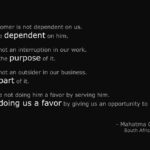Early this week my bank sent out a notice on Twitter to all its customers, indicating that an ongoing problem with access to services on a multi-bank ATM platform had been resolved and that we could now use these widely available ATMS. I looked at their communication long and hard and being the wayward wandering teacher that I am, decided to fire a salvo given I felt that they were not empathetic towards us. The service had stalled for the last four months and at a personal level had caused great inconvenience as it had meant looking for other ATMs not as conveniently located.
I responded via the same medium and politely mentioned “it would also be really nice to thank us for our patience and apologise for the inconvenience we’ve faced in those months yes?” And yes you guessed right – there was no response to my tweet. I felt taken for granted, granted that we’d greatly suffered (ok I exaggerate a little) and now that the problem had been solved the bank was happy to let us know that and toot their horn, but not acknowledge the inconvenience caused.
The second part of this story compounds this situation. On Monday I went to one of these ATMs and it rudely rejected my card. I got the same message that we had been getting during the outage period – “Sorry we cannot complete the transaction using your card”. I paused inside this ATM for a moment to recollect if indeed the Twitter message had been real or if I dreamed it up and then remembered with clarity that it had truly been sent out.
I exited the ATM booth, called up the bank call centre and explained what had happened and the call centre agent took down my details and said she would look into it and revert. This didn’t happen. The next day I sent a response Tweet on the same conversation thread where the Bank had issued their advisory and gave details of the ATM and time when my attempt to use my card was rejected. After about an hour a customer service agent telephoned and told me the reason I was unable to access services, was because the service re-collapsed and wasn’t working and they were working round the clock to resolve the problem.
At this point I asked her if she thought it may be a good idea to write back to the same customers they had written to earlier to notify them of the change in status and spare them the inconvenience of going to try and facing rejection. She agreed with me and responded in some scripted form about talking to her supervisor about it. Right there I bet my grandmother’s most precious pearls that it wasn’t going to happen, and true to form it is five days later and no such communication has come through.
Here’s my question..…….Why are organizations afraid to communicate when there is service failure? What is the underlying fear? What scares them? Do they think they will look bad? Is it the inherent need to not ‘air dirty linen in public’? What’s the motivation for it? Is it that they haven’t plugged into the stream that washes away ill will when a company pre-empts a customer complaint? Have they not empathized with the customer in that situation and thought of what they’d like done if roles were reversed?
This reminded me of an interesting article a friend sent to me on empathy and customer service that had this powerful ending – “Empathy, getting inside the heads of the people you’re trying to serve, was my strongest lesson I had from that experience as a room service waiter.First-class customer service is all about empathy for the customer” Paul Hemp Contributing Editor, Harvard Business Review Group
If we put on the weighing scale balance tray on one end ‘dirty linen’ from the provider informing customers that a service is down so that they may plan accordingly, and ‘dirty linen’ aired by unhappy frustrated customers to their networks ranting and raving about bad service, which tray would weigh heavier on the bottom line? What would cause the bigger dent?
The wisdom of communication, in fact in some instances over communication, to customers in event things have gone awry, gives the supplier the opportunity to put in some positive element and throw in an update of what is being done to rectify the problem. This gives customers the reassurance that they will know in advance when things are not alright and they will be informed when the status is returned to normal. That’s reliability, and reliability is what customers are looking for and crave.
So the sooner businesses realize that when things are bad is when the over- communication stream needs to start flowing, the better it will be for them, their customers and ultimately their bottom line. The moral of this story? Put on your brave face and go face the spear wielders, you will be surprised at how your candid explanation will elicit sympathy, empathy and ultimately – loyalty.







